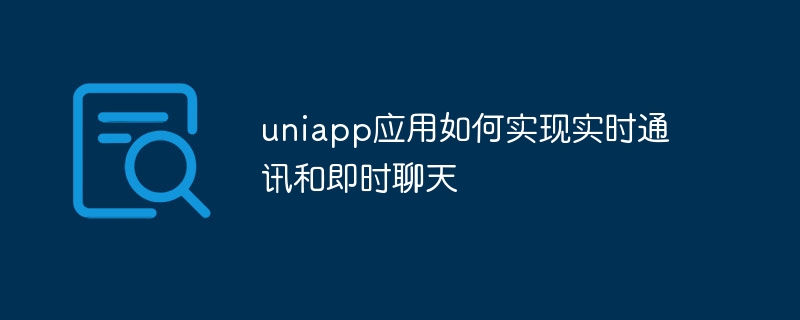

UniApp is a cross-platform application development framework that can quickly build various types of applications, including real-time messaging and instant chat applications. This article will introduce how to implement real-time communication and instant chat functions in UniApp applications, and provide some specific code examples.
1. Real-time communication
Real-time communication refers to the immediate response when transferring information between users. Common application scenarios include online customer service, real-time message push, etc. Real-time communication in UniApp can be achieved with the help of WebSocket protocol. The following is the sample code:
Introduce the WebSocket library in main.js
import * as io from '@/libs/socket.io.js'; Vue.prototype.$io = io;
Create a WebSocket connection in a page that requires real-time communication
onLoad() {
this.socket = this.$io('wss://your-websocket-url');
this.socket.on('connect', () => {
console.log('WebSocket连接成功');
});
this.socket.on('message', (data) => {
console.log('接收到消息:', data);
// 处理接收到的消息
});
},
onUnload() {
if (this.socket) {
this.socket.close();
}
}Send a message
sendMessage() {
this.socket.emit('message', {
content: 'Hello',
userId: '123'
});
}In the above example code, by introducing A WebSocket library creates a WebSocket connection and listens to the message event after the connection is successful, which is used to receive and process messages sent by the server. When sending a message, call the socket.emit method to send the data to the server.
2. Instant Chat
The instant chat function is an application of real-time communication, which realizes real-time dialogue between users through the chat window. The following aspects need to be considered when implementing instant chat in UniApp:
The following is a sample code:
Create a chat page
<template>
<view>
<scroll-view class="chat-list" scroll-y>
<view v-for="(message, index) in messages" :key="index">
{{ message }}
</view>
</scroll-view>
<input class="chat-input" type="text" v-model="inputMessage" @confirm="sendMessage" placeholder="请输入消息内容" />
<button class="send-btn" @click="sendMessage">发送</button>
</view>
</template>
<script>
export default {
data() {
return {
inputMessage: '',
messages: []
}
},
methods: {
sendMessage() {
const message = {
content: this.inputMessage,
sender: 'UserA', // 发送者
receiver: 'UserB' // 接收者
};
this.socket.emit('message', message);
this.messages.push(message);
this.inputMessage = '';
this.scrollToBottom();
},
scrollToBottom() {
// 滚动到底部
}
},
created() {
this.socket = this.$io('wss://your-websocket-url');
this.socket.on('connect', () => {
console.log('WebSocket连接成功');
});
this.socket.on('message', (message) => {
console.log('接收到消息:', message);
this.messages.push(message);
this.scrollToBottom();
});
},
beforeDestory() {
if (this.socket) {
this.socket.close();
}
}
}
</script>In the above code, the chat page contains a A message list and an input box. After the user enters the message, the message is sent to the server by clicking the Send button or pressing the Enter key. The server then forwards the message to the recipient, adds the message to the message list, and displays it on the page in real time.
To sum up, the main steps to implement real-time communication and instant chat functions in UniApp applications include establishing WebSocket connections, sending and receiving messages, and updating chat records in real time. Through the above sample code, we can quickly implement real-time communication and instant chat functions in the UniApp application.
The above is the detailed content of How uniapp application realizes real-time communication and instant chat. For more information, please follow other related articles on the PHP Chinese website!
 ie shortcut cannot be deleted
ie shortcut cannot be deleted
 Mac shortcut key list
Mac shortcut key list
 How to modify folder 777 permissions
How to modify folder 777 permissions
 How to connect asp to access database
How to connect asp to access database
 How to read macro control data in javascript
How to read macro control data in javascript
 The difference between console cable and network cable
The difference between console cable and network cable
 How to represent negative numbers in binary
How to represent negative numbers in binary
 What does wifi deactivated mean?
What does wifi deactivated mean?




